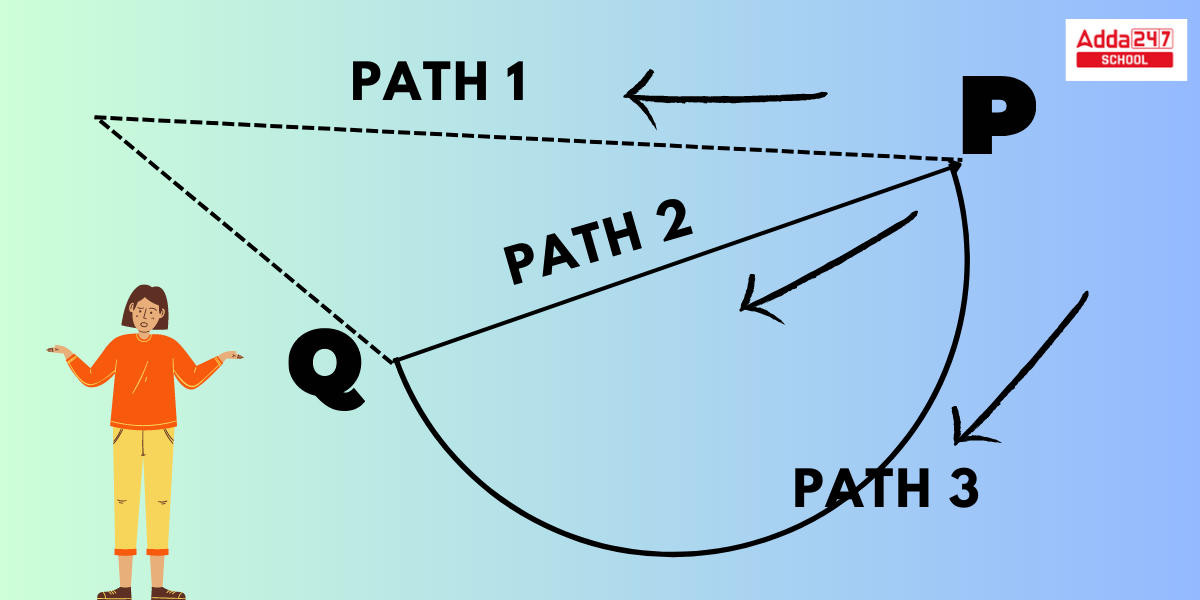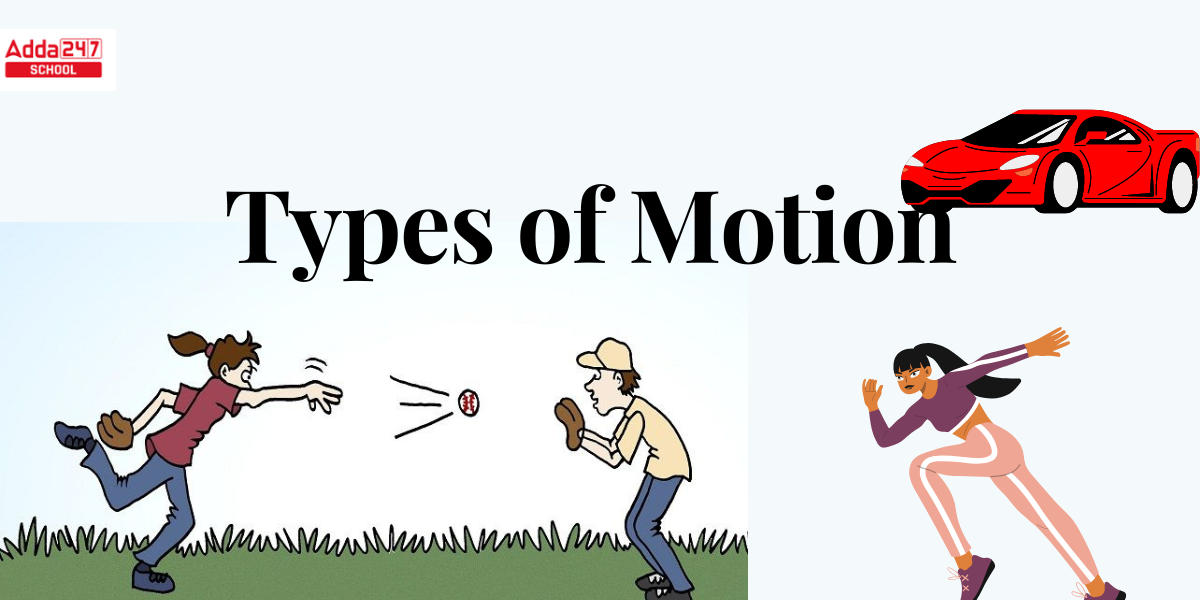There is a perpetual motion across the entire universe. Motion is defined as the change in position or alignment of a body over time. Motion is defined as a change in an object’s location with regard to time. Walking, earth motion, running, train motion, and other daily activities are examples of motion. Aside from that, the fundamental particle of matter, the atom, is likewise in continual motion. This means that every physical procedure in this universe has some form of motion, which might be slow or quick, but it is always present. here in this article, we will dive into different types of motion and their proper examples.
Motion
Motion refers to the change in position of an object with respect to its surroundings in a given period of time. It is a fundamental concept in physics and is described by various parameters such as speed, velocity, acceleration, and displacement.
Types of Motion
When we compare the object’s new position to its initial position, then only we can spot any movement. A motion is defined as any change in the location of an item with regard to time. There are various things that you can perceive as moving, whereas certain objects, such as the Earth, appear to remain motionless. Motion can be either fast or slow, yet motion exists. Because of the importance of different types of motion in the physical world, we must devote adequate attention to its research. Everything on Earth that appears to be stationary is actually moving because of the Earth’s rotation and revolution.
Types of Motion in Class 9 Physics
Motion is defined as the continual modification of positions and configurations in space, and it may be used in a variety of physics systems, including radiation, space-time, etc. as well as to shapes, pictures, and boundaries. There are various types of motion that are classified according to various criteria. The basis of division can be based on the nature of the movement, the condition of motions, and the direction, which are as follows:

- Linear Motion
- Rotatory Motion
- Oscillatory Motion
- Uniform Motion
- Non-uniform Motion
- One-dimensional Motion
- Two-dimensional Motion
- Three-dimensional Motion
Types of Motion Class 9 Parameters of Motion
The terms distance and displacement are used to describe the position change. If someone asks how far P is from Q, we can’t offer a clear response because it depends on the path chosen. It may or may not be the same for all of the paths shown in the illustration. However, because there is a straight line connecting the two places, we can always offer a clear answer for displacement. In other words, displacement is simply the shortest distance between two places, which is Path 2 in our example. It also has a specific direction from P to Q. The following terms are vital in determining motion: distance, speed, displacement, and time.

How many Types of Motion and Their Examples
15 Motion refers to the act or process of changing position or location. Here are some examples of different types of motion:
Linear Motion: Objects moving in a straight line. For example, a car driving down a straight road.
Circular Motion: Objects moving in a circular path. For example, the Moon orbiting the Earth or a spinning top.
Rotational Motion: Objects rotating around an axis. For example, a wheel turning on an axle.
Oscillatory Motion: Back-and-forth or repetitive motion. For example, a pendulum swinging or a vibrating guitar string.
Translational Motion: The entire object moves from one place to another. For example, a person walking from one room to another.
Periodic Motion: Motion that repeats at regular intervals. For example, the swinging of a grandfather clock pendulum.
Brownian Motion: The random motion of particles suspended in a fluid (liquid or gas) resulting from their collision with fast-moving atoms or molecules. This is commonly observed with dust particles in the air or smoke in a room.
Projectile Motion: The motion of an object that is projected into the air and is subject only to the force of gravity and air resistance (if applicable). For example, a baseball being thrown or a rocket launched into space.
Wave Motion: The transfer of energy through a medium without the actual transfer of matter. Examples include water waves, sound waves, and light waves.
Turbulent Motion: Chaotic and irregular motion characterized by swirling and eddying fluid flows. It can be observed in turbulent water currents, atmospheric conditions, and other natural phenomena.
Rolling Motion: A combination of linear and rotational motion. It’s what occurs when a wheel rolls along a surface.
Harmonic Motion: A type of oscillatory motion where the object moves back and forth around an equilibrium position. Examples include a mass-spring system or a vibrating tuning fork.
Convection Motion: The movement of fluids (liquids or gases) due to differences in temperature. For example, warm air rising and cool air sinks in a room, creating air currents.
Magnetic Motion: The motion of charged particles in response to magnetic forces. This can be observed in the behavior of electrons in an electric circuit.
Tidal Motion: The rising and falling of ocean water levels due to the gravitational pull of the Moon and the Sun.
Different Types of Motion with Examples Class 9 Project
Now we’re going to quickly understand, different types of motion with examples for class 9.
Oscillatory Motion
- An oscillatory motion is one that continually repeats itself. It is expected that oscillatory motion will continue indefinitely in the absence of friction, but in practice, it will eventually halt by achieving equilibrium.
- The youngster swinging, The pendulum of a clock, the string of a guitar, and so on are examples of Oscillatory motion.
Linear Motion
- Linear motion is defined as motion in a straight line with no divergence. The movement of particles from one point to another in a straight line, referred to as Rectilinear motion, or a curved path, referred to as Curvilinear motion.
- Train motion, football motion, and car motion on the street are some examples.
Rotational Motion
- Rotational motion occurs when an object travels along its axis and each of its pieces moves for various distances in a given length of time.
- Examples of rotational motion include a moving vehicle’s wheel turning or the Earth revolving on its own axis.
Translational Motion
Translational motion happens when all portions of an object move the same distance in an identical amount of time. There are two types of translation motion: curvilinear motion and rectilinear motion.
Uniform Motion
- Uniform motion happens when an object moves at a constant speed in a specific direction at regular intervals.
- For example, a train in uniform motion is one that goes at a constant pace along a straight line. When a train travels in a straight line at a constant speed, it is said to be in uniform motion.
- Other examples are a car driving at a constant speed on a straight road, a flying airplane at a consistent height, and so on.
Curvilinear Motion
- When an object is in transactional motion and follows a curved path, it is said to be in Curvilinear Motion.
Non-Uniform Motion
- Non-uniform motion occurs when an object moves at a different velocity at regular intervals of time and covers a different distance in intervals of equal time. The magnitude of acceleration will be non-zero in this case.
- A biker riding his bike on a crooked path is an example of non-uniform motion.
Periodic Motion
- Periodic motion is similar to oscillatory motion in that it continues to recur at equal time intervals.
Circular Motion
- When an object moves in a circular path continuously, it is said to be in circular motion. The object speed should be steady in this case.
One-Dimensional Motion
- One-dimensional motion is defined as motion in a straight line or in a single direction.
- An automobile or a person traveling down a straight road or jogging on a straight track, for example.
Two-Dimensional Motion
- Two-dimensional motion happens in the axis’s horizontal and vertical components.
- Example – Throwing a rock or kicking a ball, for example, produces a projectile pattern of motion with both a vertical and a horizontal component.
Three-Dimensional Motion
- This Three-dimensional motion takes place in all three axes, namely X, Y, and Z.
- Gyroscope movement as an example
| Related posts | |
| Types of Angles | Types of Triangles |
| Types of Teeth | Types of Bank |
| Types of Fever | |









 CUET UG Final Answer Key 2025 Revised, D...
CUET UG Final Answer Key 2025 Revised, D...
 DU Cut off 2025, Delhi University Expect...
DU Cut off 2025, Delhi University Expect...
 OUAT Result 2025 OUT @ouat.nic.in: Check...
OUAT Result 2025 OUT @ouat.nic.in: Check...









